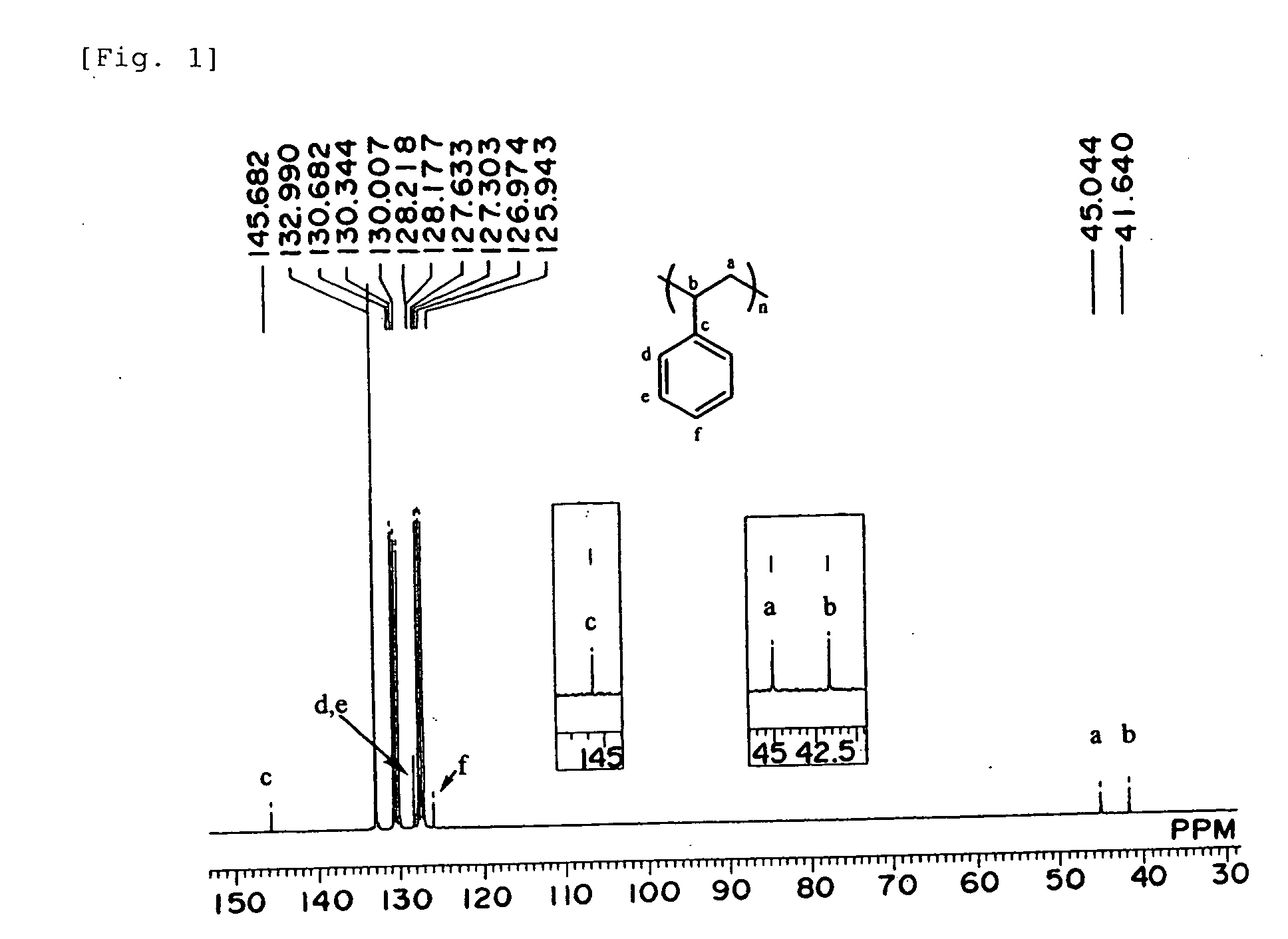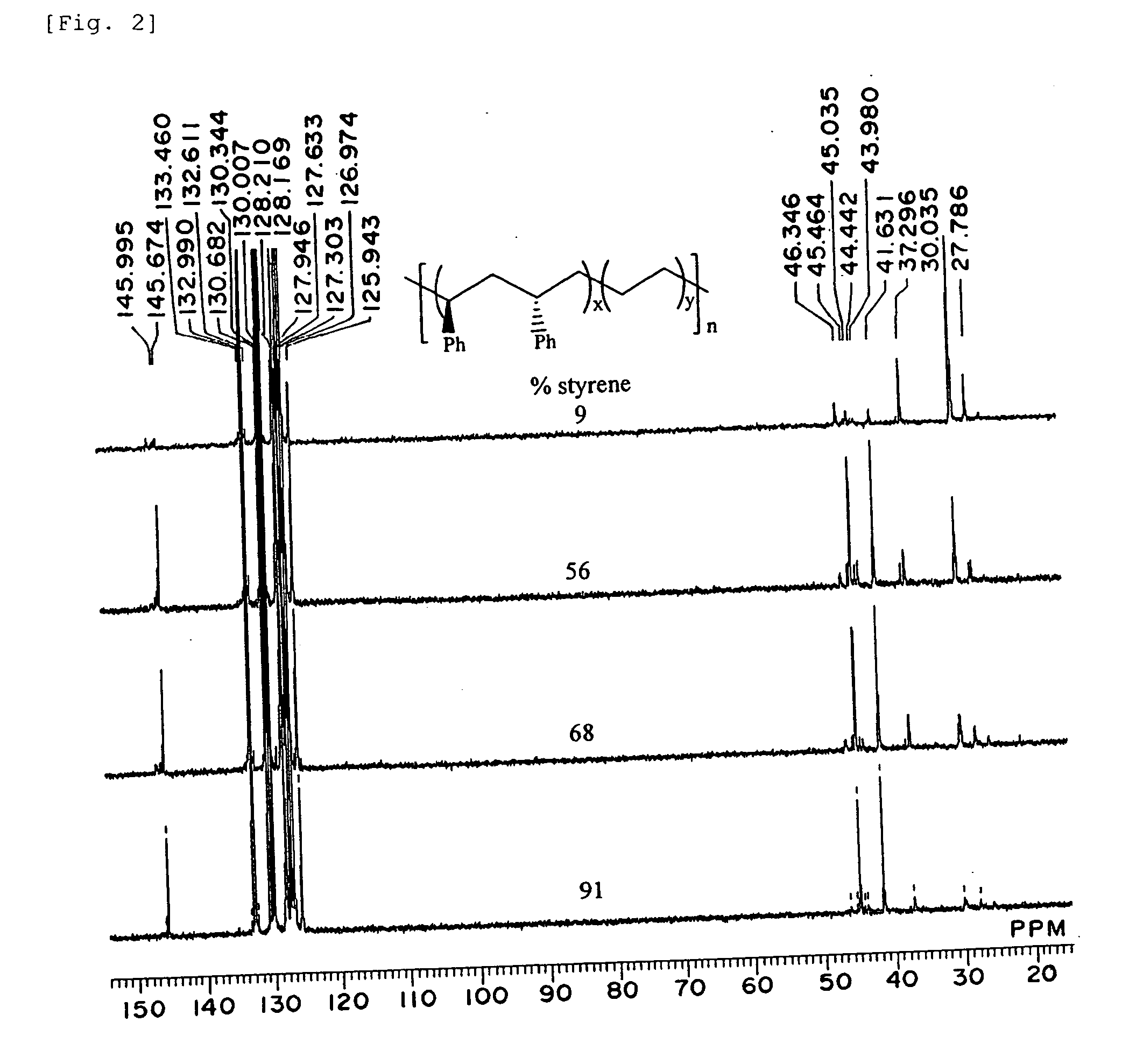Polymerization Catalyst Compositions Containing Metallocene Complexes and Polymers Produced by Using the Same
a technology of polymerization catalyst and complex, which is applied in the direction of physical/chemical process catalyst, organic compound/hydride/coordination complex catalyst, physical/chemical process catalyst, etc., can solve the problems of insufficient catalyst activity in the polymerization reaction, additional improvement, and difficulty in formation of sps or the like, etc., to achieve high syndiotactic chain, high processibility, and high quality
- Summary
- Abstract
- Description
- Claims
- Application Information
AI Technical Summary
Benefits of technology
Problems solved by technology
Method used
Image
Examples
example 1
[0466] To a 100 ml-glass reaction vessel, a solution (5 ml) of (C5Me4SiMe3)Sc(CH2SiMe3)2(THF) (10 mg, 21 μmol) in toluene and a solution (7 ml) of [Ph3C][B(C6F5)4] (19 mg, 21 μmol) in toluene were successively added. After one minute, styrene (2.148 g, 21 mmol) was added to the obtained solution while the solution was vigorously stirred (stirred by a magnetic stirrer). Viscosity of the solution increased in several seconds to stop the stirring. The reaction mixture was poured into methanol (400 ml) to precipitate a polymer. The polymer of a white powder was filtrated, and dried at 60° C. under reduced pressure, to thereby obtain 2.14 g (constant weight) (100%) of polymer.
examples 2 to 9
[0467] (1) Example 2: polystyrene was obtained by the same method as that of Example 1 except that the amount of styrene was changed to 10.5 mmol. [0468] (2) Example 3: polystyrene was obtained by the same method as that of Example 1 except that the amount of styrene was changed to 14.7 mmol. [0469] (3) Example 4: polystyrene was obtained by the same method as that of Example 1 except that the amount of styrene was changed to 31.5 mmol. [0470] (4) Example 5: polystyrene was obtained by the same method as that of Example 1 except that the amount of styrene was changed to 42.0 mmol. [0471] (5) Example 6: polystyrene was obtained by the same method as that of Example 1 except that the amount of styrene was changed to 52.5 mmol. [0472] (6) Example 7: polystyrene was obtained by the same method as that of Example 1 except that: the complex was changed to (C5Me4SiMe3)Y(CH2SiMe3)2(THF) (21 μmol); the amount of styrene was changed to 2.1 mmol; and the reaction ...
examples 12 to 16
Production of Ethylene-styrene Copolymer (Random Copolymer) or the Like
[0494] (1) Example 12: an ethylene-styrene copolymer was obtained by the same method as that of Example 11 except that the amount of styrene was changed to 10 mmol. [0495] (2) Example 13: an ethylene-styrene copolymer was obtained by the same method as that of Example 11 except that the amount of styrene was changed to 31 mmol. [0496] (3) Example 14: an ethylene-styrene copolymer was obtained by the same method as that of Example 11 except that the amount of styrene was changed to 41 mmol. [0497] (4) Example 15: a styrene copolymer was obtained by the same method as that of Example 11 except that supply of ethylene was stopped. [0498] (5) Example 16: an ethylene copolymer was obtained by the same method as that of Example 11 except that the amount of styrene was changed to 0 mmol.
[0499] Table 2 provides a summary of the production methods of polymers of Examples 11 to 16 and the physical properties of the polym...
PUM
| Property | Measurement | Unit |
|---|---|---|
| Fraction | aaaaa | aaaaa |
| Volume | aaaaa | aaaaa |
| Volume | aaaaa | aaaaa |
Abstract
Description
Claims
Application Information
 Login to View More
Login to View More - R&D
- Intellectual Property
- Life Sciences
- Materials
- Tech Scout
- Unparalleled Data Quality
- Higher Quality Content
- 60% Fewer Hallucinations
Browse by: Latest US Patents, China's latest patents, Technical Efficacy Thesaurus, Application Domain, Technology Topic, Popular Technical Reports.
© 2025 PatSnap. All rights reserved.Legal|Privacy policy|Modern Slavery Act Transparency Statement|Sitemap|About US| Contact US: help@patsnap.com



